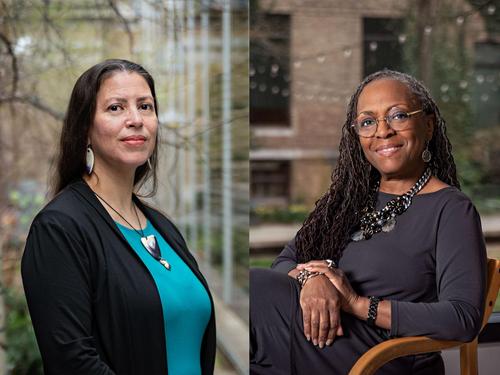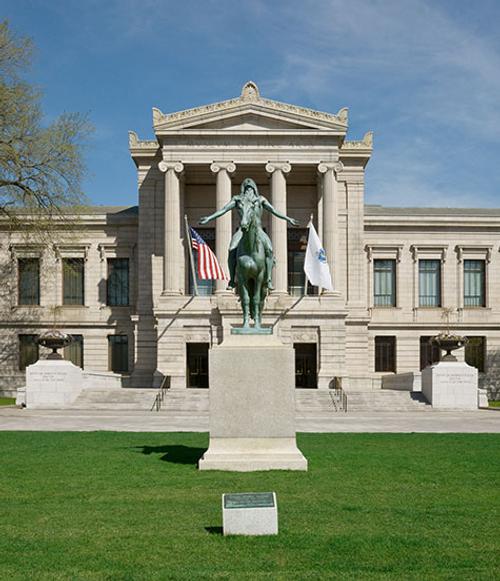Ekua Holmes and Elizabeth James-Perry's 'Garden for Boston' to Transform Grounds Outside MFA Boston
- BOSTON, Massachusetts
- /
- May 12, 2021

This spring, the Museum of Fine Arts, Boston (MFA), will launch Garden for Boston, a new outdoor project by local artists and activists Ekua Holmes (African American, born 1955) and Elizabeth James-Perry (Aquinnah Wampanoag, born 1973) that welcomes visitors and opens conversations about the land that the Museum occupies. For more than a century, the focal point of the MFA’s main entrance has been Cyrus Dallin’s Appeal to the Great Spirit (1909), a depiction of a Native American figure that represents an icon of the Museum for some and a painful stereotype for others. From May to September, two installations by James-Perry and Holmes will reshape the grounds around the monumental sculpture with sunflowers and corn, transforming the space into a blooming summer garden that represents the resilience, strength and hope of both artists, their communities and their ancestors. Garden for Boston will further be activated through both in-person and virtual programs, including a series of public discussions with artists, scholars and thought leaders about the deep connections and intersections between Black and Indigenous histories in Boston as well as a harvest celebration in late September.

Check the museum website for public programs.
“These path-breaking projects will transform the entrance of the MFA for our visitors, opening up new conversations with the neighborhoods and communities beyond our doors about our history, the land the Museum occupies, and the future of monuments on our campus and in our city,” said Matthew Teitelbaum, Ann and Graham Gund Director.
Holmes’ installation, Radiant Community, will feature some 3,000 sunflowers of four varieties, planted in collaboration with United Neighbors of Lower Roxbury Community Gardens. Bathing a prominent section of the MFA’s grounds in a field of color, the installation will amplify the power of self-determination as a tool to change one’s community. The planting, on the east side of the MFA’s Huntington Avenue lawn, is an extension of Holmes’ ongoing “Roxbury Sunflower Project,” which uses sunflowers to spread beauty and hope throughout the historically Black Boston neighborhood where the artist has lived since childhood.
“Sunflowers represent, among other things, resilience, self-determination and the ability for a community to evolve and emerge while staying grounded in its history and traditions,” said Holmes. “Radiant Community is an invitation for the public to be surrounded by beauty, color and fragrance. The sunflowers’ essential attributes mirror those that are reflected in the cultural traditions of Roxbury’s Black community and must now be collectively amplified in our society.”
James-Perry’s installation, Raven Reshapes Boston: A Native Corn Garden at the MFA, will draw on planting techniques that have been used by local Indigenous people for thousands of years, centering reciprocal relationships between humans and the land. The artist and her collaborators will create a field of corn, beans and sedges—grown in mounds using a traditional Woodlands Native American method—in the shape of a horseshoe crab and framed by crushed quahog shells. Over time, the corn will surround Dallin’s Appeal to the Great Spirit—made by a white artist for white audiences—emphasizing continued Native presence and serving as a counterproposal to the misrepresentations and erasures embodied by the sculpture.
“Raven Reshapes Boston is a nod to the eastern Native story about the traditional knowledge keeper, Raven, who brought corn to the region for Native women to grow and sustain their families. The garden is meant to welcome, intrigue and provoke discussion. Situated around the Dallin statue, it will be a lively and authentically Native counterpoint to the controversial figure,” said James-Perry. “The horseshoe crab shape, along with the white crushed oyster shell border, connects the planting to my coastal identity. It recalls rich sea harvests and coastal feasts, and is a reminder of the shell middens once ubiquitous in what is now a concrete cityscape. The garden is a reclamation of Boston as Indigenous land.”
In conjunction with the plantings, Holmes and James-Perry will design a series of billboards on the lawn that will explore their shared connections to the Boston area and distinct approaches to planting and growing. Additionally, Beyond MEASURE Productions—a Boston-based, diasporic-owned filmmaking company—will create a documentary film about Garden for Boston that will be released on mfa.org in the fall.
Garden for Boston continues the MFA’s multi-year effort to recontextualize Appeal to the Great Spirit—a depiction of a Native American man astride a horse with his arms outstretched and dressed in a mix of Lakota- and Diné-syle regalia, which has stood outside the Museum since 1912. Today, MFA interpretation recognizes that the sculpture is based on an inaccurate accumulation of Native symbols and ultimately capitalized on the degrading myth of the “vanishing race,” which portrayed Indigenous peoples as disappearing in the face of modern civilization—both appropriating and misrepresenting Native American culture. Critics in the early 20th century praised the sculpture for its “fine dignity” while describing its figure, and Dallin himself likely believed his works honored Indigenous peoples and even critiqued the social injustices that they faced. In recent years, amid international debates about cultural appropriation, public monuments and Indigenous erasure, the Museum has worked to reconsider and reinterpret the work, with public discussions and visitor feedback informing the ongoing process.
















